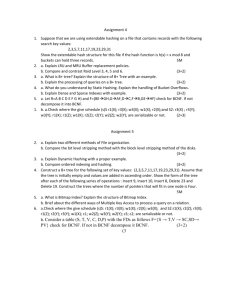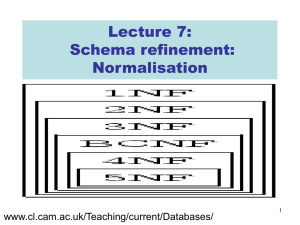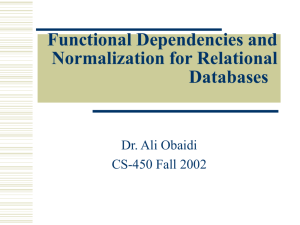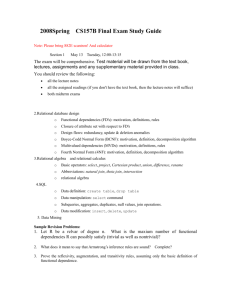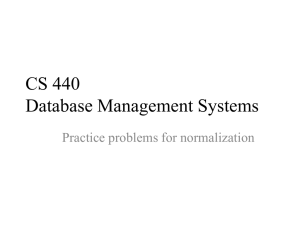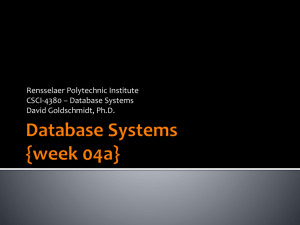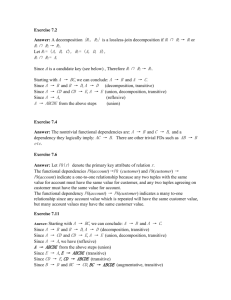clear
advertisement
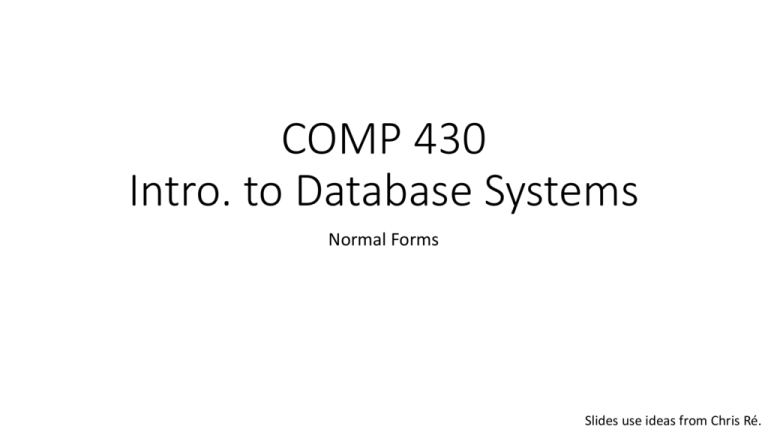
COMP 430
Intro. to Database Systems
Normal Forms
Slides use ideas from Chris Ré.
What makes a good design?
During design process:
• Choose attributes & types appropriately.
• Pick entity sets appropriately.
• Associate attributes with entity sets appropriately.
Follow common patterns.
Any objective criteria for evaluating our decisions?
Normal forms
Implies
Implies
Almost implies
Implies
Implies
Implies
Implies
• Domain/key normal form
• 6th normal form
• 5th normal form
• 4th normal form
• Boyce-Codd normal form = 3.5th normal form
• 3rd normal form
• 2nd normal form
• 1st normal form
Based on functional
dependencies, i.e.,
what attributes
depend upon.
Goal: Prevent DB
anomalies.
Intuition
(3NF) “[Every] non-key field must provide a fact about the key, the
whole key, and nothing but the key.” – Bill Kent
(BCNF) “Each attribute must represent a fact about the key, the whole
key, and nothing but the key.” – Chris Date
Course(crn, dept_code, course_number, title)
Student(student_id, first_name, last_name)
Enrollment(crn, student_id, grade)
Denormalization
We’ll later see that there are also reasons to not use 3NF / BCNF.
st
1
normal form
instructor
days_teaches
instructor
day_teaches
John
{M,T,W,Th,F}
John
M
John
{M,T,W,Th,F}
John
T
Scott
{T,Th}
John
W
…
…
John
Th
John
F
Scott
T
Scott
Th
…
…
Table represents a mathematical relation:
• Each record unique.
• Single value per record & attribute.
Anomalies
Update, delete, insert
Update anomalies caused by redundancy
student
course
room
John
COMP 130
BRK 101
Jane
COMP 130
BRK 101
John
COMP 430
DCH 1070
Mary
COMP 430
DCH 1070
Sue
COMP 430
DCH 1070
…
…
…
Assume no separate
Student or Course tables.
Updating one room results in
inconsistency = update anomaly.
Delete anomalies caused by poor attribute
grouping
student
…
course
…
room
…
No enrolled students results in
no information about course =
delete anomaly.
Assume no separate
Student or Course tables.
Insert anomalies caused by poor attribute
grouping
student
course
room
John
COMP 130
BRK 101
Jane
COMP 130
BRK 101
John
COMP 430
DCH 1070
Mary
COMP 430
DCH 1070
Sue
COMP 430
DCH 1070
…
COMP 600
DCH 1070
…
…
…
Assume no separate
Student or Course tables.
Need an enrolled student to
reserve a room = insert anomaly.
Functional dependencies
FDs identify relationships between attributes
Process:
1. Start with some relational schema.
2. Identify its functional dependences.
3. Use these to design a better schema.
Not only identify
problems, but fix them.
Roadmap
• Define FDs.
• Define closures to find all FDs.
• Define superkeys to determine what should be key.
• Apply definitions to 3NF, BCNF.
• Glimpse at what’s beyond 3NF, BCNF.
With examples &
activities, of course!
Intuition:
Attribute X (room) depends on Y (course).
X (room) should be a non-key attribute in a table with Y (course) as key.
FD – definition
Let S, T be sets of attributes. Let R be a relation.
S functionally determines T (S T) holds on R
iff
for all valid tuples t1, t2 in R, if t1[S]=t2[S], then t1[T]=t2[T].
I.e., all the tuples
that fit the intended
meaning of R.
S T is a functional dependency.
FD – an illustration
S1
…
Sm
T1
…
Tn
t1
John
Smith Jr.
dog
blue
17
t2
John
Smith Jr.
dog
blue
17
If t1,t2 agree here…
…they also agree here!
FD example
emp_id
E0045
E3542
E1111
E9999
name
Smith
Mike
Smith
Mary
phone
1234
position
Clerk
9876 Salesrep
9876 Salesrep
1234
Lawyer
{position} {phone}
That a FD holds for one instance doesn’t
imply that does for all instances.
emp_id
E0045
E3542
E1111
E9999
name
Smith
Mike
Smith
Mary
phone
position
1234 Clerk
9876
Salesrep
9876
Salesrep
1234 Lawyer
Not {phone} {position}
Two ways FDs are used
Let F be a set of FDs. Let R be a relation.
• F can specify a set of constraints on R’s tuples.
Does F hold on R?
• Considered part of R’s schema.
• To test whether R’s tuples are valid under F.
Does R satisfy F?
Superkey – definition
Let S be a set of attributes. Let R be a relation.
Here, R means the
set of all of the
relation’s attributes.
S is a superkey of R
iff
S R,
i.e., for all valid tuples t1, t2 in R, if t1[S]=t2[S], then t1[R]=t2[R].
Intuition: R’s attributes should be dependent on exactly the primary key.
Activity – Find FDs in this instance
a
b
c
d
e
1
2
4
3
6
3
2
5
1
8
1
4
4
5
7
1
2
4
3
6
3
2
5
1
8
Find at least three FDs which
hold on this instance:
• { }{ }
• { }{ }
• { }{ }
Problems finding FDs
• Can’t necessarily show a FD holds on all instances.
• Potentially large number – How to find them all?
• Start with subproblem – Given a set of FDs, what other FDs must hold?
Logical implication of FDs – example
name
Gizmo
Widget
color
Green
Black
category
dept
Gadget
Toys
Gadget
Toys
Gizmo
Green
Whatsit
Given:
{name} {color}
{category} {dept}
{color, category} {price}
Garden
price
49
59
99
Logically implies:
{name, category} {price}
Logical implication rules
Armstrong’s Axioms
• Reflexivity:
• Augmentation:
• Transitivity:
If B A, then A B.
If A B, then AC BC.
If A B and B C, then A C.
Sound: Only imply
correct FDs.
Complete: Imply
all correct FDs.
Derivable rules:
• Union:
• Decomposition:
• Pseudo-transitivity:
If A B and A C, then A BC.
If A BC, then A B and A C.
If A B and BC D, then AC D.
Standard
notation for
union of FD sets.
Activity – using FD implication rules
name
Gizmo
color
Green
category
dept
Gadget
Toys
Widget
Gizmo
Black
Green
Gadget
Whatsit
Given:
{name} {color}
{category} {dept}
{color, category} {price}
Toys
Garden
price
49
59
99
Logical implication:
{name, category} {price}
{name, category} {name}
{name, category} {color}
{name, category} {category}
{name, category} {color, category}
Rule(s)?
Closures – all logically implied FDs
Let F be a set of FDs. Let A, B be sets of attributes.
The closure of F (F+) is the set of all FDs logically implied by F.
The closure of A (A+) is the set of all attributes B such that A B.
Closure of attribute sets
Given:
{name} {color}
{category} {dept}
{color, category} {price}
Some closures:
{name}+
{name, category} +
{color} +
= {name, color}
= {name, category, color, dept, price}
= {color}
Algorithm for closure of attribute sets
Closure(A) =
Result = A
Repeat until A doesn’t change:
For each FD B C:
if B Result,
then add C to Result
Return Result
Simple algorithm quadratic in size of F.
Complicated linear algorithm exists.
Given:
{name} {color}
{category} {dept}
{color, category} {price}
Compute:
{name, category} +
Activity – use closure algorithm
Closure(A) =
Result = A
Repeat until A doesn’t change:
For each FD B C:
if B Result,
then add C to Result
Return Result
Given:
{a, b} {c}
{a, d} {e}
{b} {d}
{a, f} {b}
Compute:
{a, b} + =
{a, f} + =
Closure of FD set
Let A, B be sets of attributes:
Closure(F) =
Result =
For each subset A:
For each A B provable: For each B A+:
Add A B to Result.
Return Result.
Closure of FD set – example
Given:
{a, b} {c}
{a, d} {b}
{b} {d}
Compute attribute set closures:
{a}+ = {a}
{b}+ = {b, d}
{c}+ = {c}
{d}+ = {d}
{a, b}+ = {a, b, c, d}
{a, c}+ = {a, c}
{a, d}+ = {a, b, c, d}
{b, c}+ = {b, c, d}
{b, d}+ = {b, d}
{c, d}+ = {c, d}
{a, b, c}+ = {a, b, c, d}
{a, b, d}+ = {a, b, c, d}
{a, c, d}+ = {a, b, c, d}
{b, c, d}+ = {b, c, d}
{a, b, c, d}+ = {a, b, c, d}
Compute FDs:
{a} {a}
{b} {b}, … {d}, … {b, d}
{c} {c}
{d} {d}
{a, b} {a, b, c, d}
{a, c} {a, c}
{a, d} {a, b, c, d}
{b, c} {b, c, d}
{b, d} {b, d}
{c, d} {c, d}
{a, b, c} {a, b, c, d}
{a, b, d} {a, b, c, d}
{a, c, d} {a, b, c, d}
{b, c, d} {b, c, d}
{a, b, c, d} {a, b, c, d}
If we take A B
to be shorthand
for A B’,
where B’B.
Closure of FD set – example
Given:
{a, b} {c}
{a, d} {b}
{b} {d}
…
Compute FDs:
{a} {a}
{b} {b}, … {d}, … {b, d}
{c} {c}
{d} {d}
{a, b} {a, b, c, d}
{a, c} {a, c}
{a, d} {a, b, c, d}
{b, c} {b, c, d}
{b, d} {b, d}
{c, d} {c, d}
{a, b, c} {a, b, c, d}
{a, b, d} {a, b, c, d}
{a, c, d} {a, b, c, d}
{b, c, d} {b, c, d}
{a, b, c, d} {a, b, c, d}
Shorthand version:
{b} {d}
{a, b} {c, d}
{a, d} {b, c}
{b, c} {d}
{a, b, c} {d}
{a, b, d} {c}
{a, c, d} {b}
Eliminating trivial FDs
A B, where BA.
Replacing FDs A AB
with A B.
FD covers & equivalence
F covers G iff G can be inferred from F. I.e., G+ F+.
F and G are equivalent iff F+ = G+.
Given:
{a, b} {c}
{a, d} {b}
{b} {d}
Compute FDs:
{a} {a}
{b} {b, d}
{c} {c}
{d} {d}
{a, b} {a, b, c, d}
{a, c} {a, c}
{a, d} {a, b, c, d}
{b, c} {b, c, d}
{b, d} {b, d}
{c, d} {c, d}
{a, b, c} {a, b, c, d}
{a, b, d} {a, b, c, d}
{a, c, d} {a, b, c, d}
{b, c, d} {b, c, d}
{a, b, c, d} {a, b, c, d}
Shorthand version:
{b} {d}
{a, b} {c, d}
{a, d} {b, c}
{b, c} {d}
{a, b, c} {d}
{a, b, d} {c}
{a, c, d} {b}
Superkeys & keys
Superkeys & keys (reminder)
Let S be a set of attributes. Let R be a relation.
S is a superkey of R iff S R.
Equivalently, iff S+ = R.
A key is a minimal superkey.
We pick a key as primary key.
Superkeys & keys – example
Product(name, price, category, color)
{name, category} price
{category} color
What are superkey(s)? Key(s)?
How can you search for them?
Activity
10a-keys.ipynb
Normal forms
FD-based table normalization
While there are “bad” FDs
Decompose a table with “bad” FDs into sub-tables.
Boyce-Codd normal form (BCNF)
(BCNF) “Each attribute must represent a fact about the key, the whole
key, and nothing but the key.” – Chris Date
Ignoring trivial FDs:
• Good: X R
• Bad: X A
for A R
“Bad” because X isn’t the primary key, but it
functionally determines some of the attributes.
Thus, there is redundancy.
X is a (super)key
X is not a (super)key
BCNF – definition
Relation R is in BCNF
iff
whenever A B is a non-trivial FD in R, then A is a superkey for R.
I.e., each FD is trivial or “good”, not “bad”.
BCNF – example
name
Mary
ssn
123-45-6789
phone
713-555-1234
city
Houston
Mary
Joe
Joe
123-45-6789
987-65-4321
987-65-4321
713-555-6543
512-555-2121
512-555-1234
Houston
Austin
Austin
Find a “bad” FD.
{ssn} {name, city}
BCNF – example fixed
Decompose table into sub-tables.
name
Mary
ssn
123-45-6789
city
Houston
ssn
123-45-6789
phone
713-555-1234
Joe
987-65-4321
Austin
123-45-6789
987-65-4321
987-65-4321
713-555-6543
512-555-2121
512-555-1234
Now a “good” FD.
{ssn} {name, city}
BCNF decomposition
BCNF_decomp(R) =
Find attribute set X s.t. X+ X (not trivial) and X+ R (not superkey).
If no such X, then return R.
Let D = X+ - X. (attributes functionally determined by X)
Let N = R - X+. (attributes not functionally determined by X)
Decompose R into R1(X D) and R2(X N).
Return BCNF_decomp(R1), BCNF_decomp(R2).
BCNF decomposition – example
R(a,b,c,d,e)
{a} {b, c}
{c} {d}
BCNF_decomp(R) =
Find attribute set X s.t. X+ X and X+ R.
If no such X, then return R.
X = {a}
X+ = {a,b,c,d}
Let D = X+ - X.
Let N = R - X+.
Decompose R into R1(X D) and R2(X N).
Return BCNF_decomp(R1), BCNF_decomp(R2).
D = {b,c,d}
N = {e}
R1(a,b,c,d)
R2(a,e)
BCNF decomposition – example
R1(a,b,c,d)
{a} {b, c}
{c} {d}
BCNF_decomp(R) =
Find attribute set X s.t. X+ X and X+ R.
If no such X, then return R.
X = {c}
X+ = {c,d}
Let D = X+ - X.
Let N = R - X+.
Decompose R into R1(X D) and R2(X N).
Return BCNF_decomp(R1), BCNF_decomp(R2).
D = {d}
N = {a,b}
R11(c,d)
R12(a,b,c)
BCNF decomposition – example
R11(c,d)
{a} {b, c}
{c} {d}
BCNF_decomp(R) =
Find attribute set X s.t. X+ X and X+ R.
If no such X, then return R.
No such X.
Let D = X+ - X.
Let N = R - X+.
Decompose R into R1(X D) and R2(X N).
Return BCNF_decomp(R1), BCNF_decomp(R2).
BCNF decomposition – example
R12(a,b,c)
{a} {b, c}
{c} {d}
BCNF_decomp(R) =
Find attribute set X s.t. X+ X and X+ R.
If no such X, then return R.
No such X.
Let D = X+ - X.
Let N = R - X+.
Decompose R into R1(X D) and R2(X N).
Return BCNF_decomp(R1), BCNF_decomp(R2).
BCNF decomposition – example
R2(a,e)
{a} {b, c}
{c} {d}
BCNF_decomp(R) =
Find attribute set X s.t. X+ X and X+ R.
If no such X, then return R.
No such X.
Let D = X+ - X.
Let N = R - X+.
Decompose R into R1(X D) and R2(X N).
Return BCNF_decomp(R1), BCNF_decomp(R2).
BCNF decomposition + keys – example
R(a,b,c,d,e)
{a} {b, c}
{c} {d}
BCNF
R11(c,d)
R12(a,b,c)
R2(a,e)
{a} {b, c}
{c} {d}
keys
R11(c,d)
R12(a,b,c)
R2(a,e)
{a} {b, c}
{c} {d}
Activity – BCNF & keys
10b-bcnf.ipynb
name
Mary
Mary
ssn
phone
city
123-45-6789 713-555-1234 Houston
123-45-6789 713-555-6543 Houston
zip
77005
77005
Joe
Joe
987-65-4321 281-555-2121 Houston
987-65-4321 281-555-1234 Houston
77005
77005
{city} {zip}
{ssn} {name, city}
Decompositions
BCNF decomposition – the good & the bad
The good:
Algorithm to detect & remove redundancies.
Standard practice.
The bad:
Sometimes some subtle, undesirable side-effects.
Decompositions & joins
Decomp.
R(A1, …, An, B1, …, Bm, C1, …, Cp)
Join???
R1(A1, …, An, B1, …, Bm)
R2(A1, …, An, C1, …, Cp)
If decomposition is lossless, a join restores the original relation.
Decomposition & join – lossless example
name
Decomp.
name
price
category
Gizmo
19.99 Gadget
OneClick
24.99 Camera
Gizmo
19.99 Camera
Join
price
Gizmo
19.99
OneClick
24.99
Gizmo
19.99
name
category
Gizmo
Gadget
OneClick
Camera
Gizmo
Camera
Decomposition & join – lossy example
name
price
category
Gizmo
19.99 Gadget
OneClick
24.99 Camera
Gizmo
name
19.99 Camera
price
category
Gizmo
19.99 Gadget
OneClick
24.99 Camera
Gizmo
24.99 Camera
OneClick
19.99 Camera
Gizmo
19.99 Camera
price
category
19.99 Gadget
Decomp.
24.99 Camera
19.99 Camera
Join
name
category
Gizmo
Gadget
OneClick
Camera
Gizmo
Camera
Loses the association between name and price.
BCNF decompositions is lossless
Lossless iff
{A1, …, An} {B1, …, Bm}
Decomp.
R(A1, …, An, B1, …, Bm, C1, …, Cp)
Join
R1(A1, …, An, B1, …, Bm)
R2(A1, …, An, C1, …, Cp)
Don’t need
{A1, …, An} {C1, …, Cp}
Holds by definition of BCNF decomposition algorithm.
BCNF can lose FD information
R(name, company, category)
{category, company} {name}
{name} {company}
Keys: {category, company},
{category, name}
Decomp.
R1(name, category)
R2(name, company)
{category, company} {name}
{name} {company}
“Bad” FD
Can’t enforce “nonlocal” FD.
name
name
company
category
Gizmo
GizmoWorks Gadget
GizmoPlus
GizmoWorks Gadget
Join
category
Gizmo
Gadget
GizmoPlus
Gadget
name
company
Gizmo
GizmoWorks
GizmoPlus
GizmoWorks
Three solutions
• Accept the BCNF tradeoff between avoiding redundancy/anomalies
and preserving FDs.
BCNF is most common choice.
• Take extra steps to enforce these FDs.
E.g., join tables and then check.
• Weaken decomposition so that no such lost FDs.
E.g., 3NF.
rd
3
normal form (3NF)
BCNF:
3NF:
Relation R is in BCNF
iff
whenever A B is a non-trivial
FD in R, then
• A is a superkey for R.
Relation R is in 3NF
Iff
whenever A B is a non-trivial
FD in R, then either:
• A is a superkey for R, or
• Every element of B is part of a
key.
3NF avoids losing FD information
R(name, company, category)
{category, company} {name}
{name} {company}
Keys: {category, company},
{category, name}
BCNF: “Bad”
3NF: “Good” because
company part of a key.
3NF allows some redundancies/anomalies
name
Redundancy. Repeating
product’s company.
company
category
Gizmo
GizmoWorks Gadget
Gizmo
GizmoWorks Camera
GizmoPlus
GizmoWorks Gadget
GizmoPlus
GizmoWorks Camera
NewThing
NULL
Insertion anomaly. Product not
yet made by any company.
Gadget
More about 3NF
• 3NF is still lossless!
• Requires somewhat more complicated decomposition algorithm.
Glimpse beyond BCNF/3NF/FDs
• 4NF – multi-valued dependencies (generalizes FDs)
• 5NF & 6NF – join dependencies
• DKNF – only domain & key constraints
Multi-value dependencies
FD: A B
MVD: A ↠ B
restaurant
The value in A determines a value for B.
The value in A determines a set of values for B.
menu_item
delivery_area
Papa John’s
Pizza
Rice Village
Papa John’s
Pizza
Rice University
Papa John’s
Pizza
Southampton
Domino’s
Pizza
Rice Village
Domino’s
Pizza
Rice University
Domino’s
Pasta
Rice Village
Domino’s
Pasta
Rice University
{restaurant} ↠ {menu_item}
{restaurant} ↠ {delivery_area}
Normal form summary
• Constraints on data/tables to limit redundancy
• Decomposition strategy/algorithm to meet constraints
• Different normal forms for different trade-offs
